Featured Exhibits
Sign up for the Newsletter
Advertise on ParachuteHistory.com
Disclaimer
Privacy Policy
About
Sleeve
One common deployment device for round parachutes in the 1960's in sport parachuting was the sleeve. The sleeve greatly reduced opening forces and allowed sport parachuting to grow.
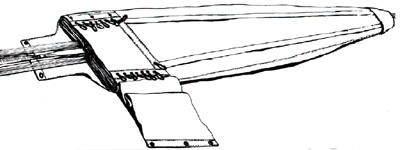
The sleeve is pulled even with the skirt.
The sleeve is made almost like a sleeve on a shirt, hence it's name. The first patent on a sleeve was in 1956 by R. L. Oakley. Jacques A. Istel filed a sleeve patent on Oct 30, 1957.
The pilot chute bridle line was tied to the sleeve's retainer line and to the sleeve bridle at the end near the pilot chute. The other end was open. The sleeve was pulled over a flaked canopy. The sleeve's closing flap was folded over and locked in place with two or four line stows. The rest of the lines were stowed by S-folding the lines back and forth across the sleeve. The line stowage cover was velcro-closed to protect the lines. The canopy, inside the sleeve was then S-folded into the pack tray.
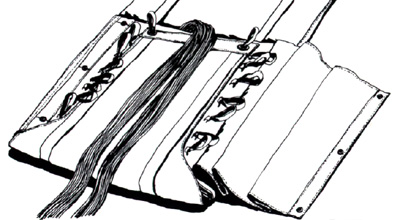
Sleeve with the end flap pulled up
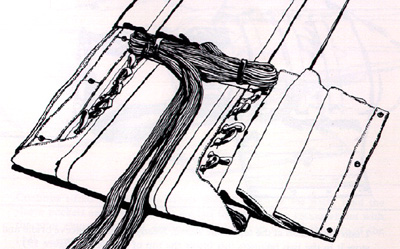
Sleeve with 2 locking stows in place
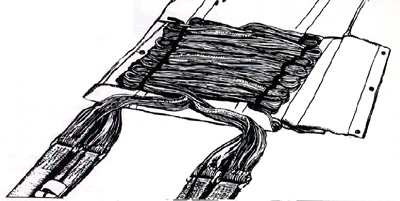
Sleeve with all lines stowed.
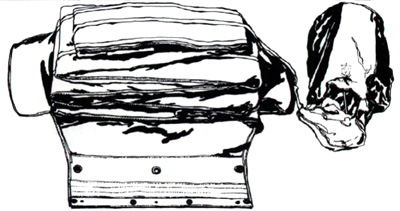
During deployment, the pilot chute pulls the sleeve out of the pack tray. Once the sleeve is completely stretched out, the lines start to unstow from the bottom of the sleeve. After the locking stows are released, the canopy comes out of the sleeve and then inflates.
One of the biggest problems with the sleeve was canopy slump. During the time the lines were unstowing, the canopy would slump inside of the sleeve. This could cause hard openings or malfunctions when the canopy was extracted from the sleeve. Stabilizer hangups were the most common malfunction caused by canopy slump.
The slump sometimes caused the locking stow rubberbands to break. The canopy could get out of the sleeve before all of the lines were unstowed. A line over malfunction, also known as a Mae-West, would often be the result of this out of sequence deployment. A double locking sleeve with 4 locking stows was developed to reduce the chance of line overs. (see photos below)
The reason canopy slump happened was primarily because the stabilizers at the lower end of the canopy took up less room inside the sleeve. The heavier and bulkier middle and top parts of the canopy would slump onto the stabilizers. Another reason was because the sleeve was too big for the canopy. The extra room inside allowed the canopy to slump.
Not all sleeves were made equal either. Some sleeves had a closing flap that did not completely block the air from entering the sleeve until the locking stows payed out. Under these conditions the canopy could catch air and blow the sleeve apart. This made for a hard opening.
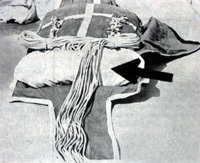
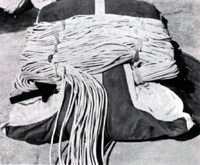
This sleeve in these photos show how the canopy is exposed to the airstream. They also show a double locking system used to prevent line over malfunctions.
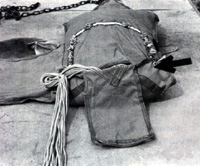
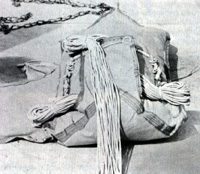
These sleeves are more effective with a flap that prevents air from reaching the canopy until the four locking stows are unstowed. The first two locking stows lock the bottom of the flap. The top two locking stows lock the top of the flap. The rest of the lines are S-folded and stowed by the rubberbands on the sleeve. The line stowage cover is to the left.
Sleeves were commonly made from cotton. Some sleeves were made from silk. Sleeves could not be made from nylon as the canopy sometimes inflated inside the sleeve. The nylon on nylon would casue friction burns. Even the thread used in the sleeve had to be cotton, as nylon thread could casue burns, melt itself during deployment. A subsequent jump on a sleeve with nylon thread could see the sleeve blow apart on opening.
[Products] | [Services]
[Join Our Mailing List] | [Advertise on ParachuteHistory.com]
[ ]
[Disclaimer] | [Privacy Policy] | [About]